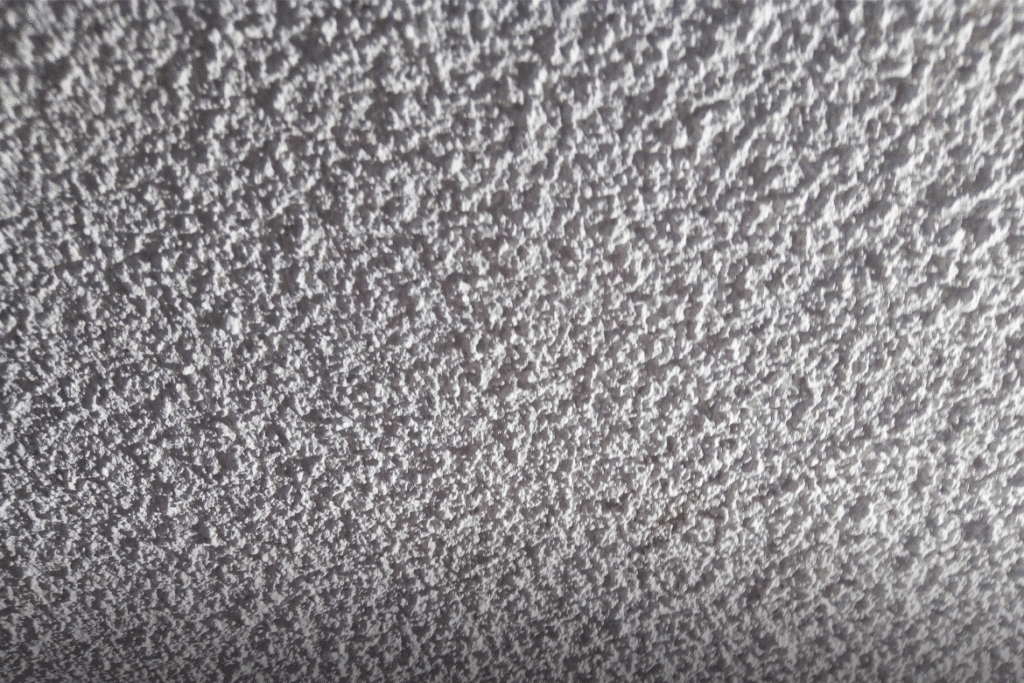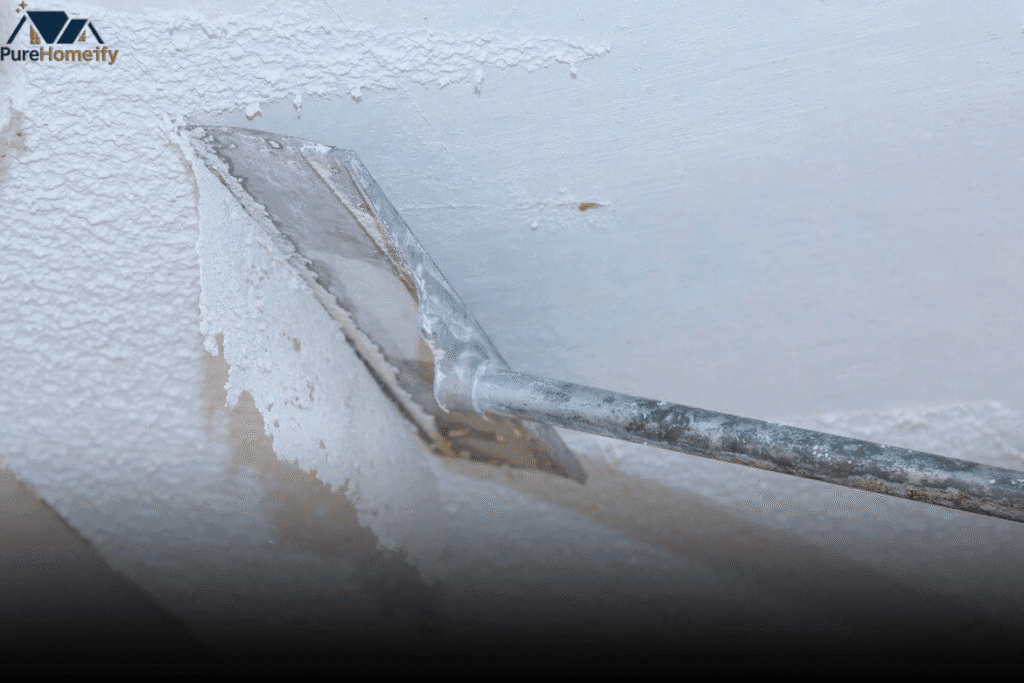Popcorn ceilings, also called acoustic ceiling texture, were a design trend in American homes from the 1940s through the 1980s. They gave walls and ceilings a stylish finish while hiding imperfections and reducing noise. What many homeowners did not know was that these ceilings often contained asbestos, one of the most dangerous asbestos-containing materials (ACM) ever used in construction. For years, asbestos was valued for its durability and fire-resistant ceiling materials qualities, but later studies revealed severe health risks, including mesothelioma from asbestos and lung cancer. This raised an urgent question still asked today: when did they stop using asbestos in popcorn ceilings across the United States?
What Are the Popcorn Ceilings and Why Were They Popular?
Popcorn ceilings became a trend between the 1940s and 1970s. They were cheap, easy to install, and perfect for hiding flaws. The bumpy design also reduced noise, which was a big advantage in apartments and suburban homes.
This finish was often called “cottage cheese” ceilings. Builders loved it because it cut labor costs and time. But many homeowners did not know that these ceilings could contain asbestos in ceilings, making them a long-term risk.
Why Was Asbestos Used in Popcorn Ceilings?
Asbestos was added because of its durability and fire resistance and insulation properties of asbestos. It kept ceilings safe from fire, made them long lasting, and even helped with sound control. Builders saw it as a miracle ingredient.
The material was also affordable. At the time, no one realized the full danger of asbestos exposure dangers. What looked like progress later caused serious health problems across the U.S.
When Did Popcorn Ceilings Stop Containing Asbestos?

The U.S. Consumer Product Safety Commission (CPSC) ban 1977 restricted asbestos in textured ceiling materials. By the early 1980s, most companies stopped using it. This period is often called the 1980s asbestos phase-out.
The Environmental Protection Agency (EPA) asbestos ban and the Asbestos Ban and Phase-Out Rule 1989 reinforced limits. Even though parts were overturned in 1991, use in asbestos-containing materials (ACM) like ceilings had already declined.
| Year | Action | Impact |
| 1977 | CPSC ban | Banned asbestos in spray-applied ceiling coatings |
| 1980s | Industry phase-out | Safer alternatives replaced asbestos |
| 1989 | EPA asbestos ban | Restricted many asbestos products |
Which Homes Are Most Likely to Have Asbestos Popcorn Ceilings?
Homes built before the mid-1980s are the most likely to contain asbestos in residential construction. Renovations after that time often replaced ceilings, but original structures may still hide asbestos.
Older houses, schools, and offices across the U.S. were built with these ceilings. Without an asbestos inspection, it is hard to know if your home is safe.
Health Risks Linked to Asbestos in Popcorn Ceilings

The health risks of asbestos exposure are severe. Inhaling fibers can cause scarring of the lungs, known as asbestosis. It can also lead to cancer, including mesothelioma from asbestos and lung cancer.
Doctors warn that no level of asbestos exposure is safe. The longer the exposure, the higher the risk. That is why asbestos laws and restrictions were put in place to protect public health.
How to Identify Asbestos in Popcorn Ceilings
Many believe they can tell by sight, but that is a myth. True popcorn ceiling asbestos identification requires lab analysis. The safest option is professional asbestos testing.
Experts take samples carefully and send them to labs for asbestos testing and confirmation. Homeowners should never try this themselves, since cutting or scraping can release fibers into the air.
Is It Safe to Live with Asbestos Popcorn Ceilings?
If left undisturbed, ceilings with asbestos-containing materials (ACM) often pose little risk. Problems arise when ceilings are damaged, drilled, or sanded during home renovation asbestos risk projects.
Living safely means avoiding contact. Sealing or ceiling encapsulation may reduce exposure, but testing is the only way to know for sure.
What Should You Do If Your Ceiling Contains Asbestos?
If asbestos is found, you have two options. The first is encapsulation vs. removal. Encapsulation seals the fibers under a protective layer. Removal, also known as asbestos abatement, takes the material out completely.
Hiring a licensed team for professional asbestos abatement is the safest choice. They follow asbestos regulations in the U.S., keeping families safe and homes clean.
Can You Remove a Popcorn Ceiling Yourself?
Some homeowners consider popcorn ceiling removal themselves. But the process is dangerous. Cutting or scraping can release invisible fibers into the air. This risk is far greater than most DIY jobs.
Because of these hazards, many states require certified contractors. Attempting removal without training can create more exposure. Trusting experts ensures compliance with asbestos laws and restrictions.
Modern Alternatives to Popcorn Ceilings
Many people now replace popcorn ceilings with modern finishes. Options include smooth ceilings, knockdown textures, or wood planks. These choices are safe, attractive, and free of asbestos-containing materials (ACM).
Conclusion
So, when did they stop using asbestos in popcorn ceilings? The turning point came in the late 1970s, with the CPSC ban 1977 and industry changes in the 1980s. By the time of the EPA asbestos ban, most ceilings were asbestos free.
Still, many older U.S. homes may contain these asbestos-containing materials (ACM). With professional asbestos testing and safe removal, homeowners can protect their health and enjoy safer living spaces.
Upgrades increase home value. They also remove the stress of hidden asbestos. For many, modern finishes offer peace of mind alongside a cleaner look.
FAQs
How to tell if a popcorn ceiling has asbestos?
It’s impossible to confirm by sight alone because asbestos fibers are microscopic. The safest way is through professional asbestos testing and lab confirmation, as disturbing the ceiling yourself can release harmful particles.
Is it worth removing an asbestos popcorn ceiling?
Yes, especially if you plan renovations or the ceiling is damaged. Popcorn ceiling removal or ceiling encapsulation lowers long-term risks from airborne fibers and can also improve your home’s value.
Can you have a popcorn ceiling without asbestos?
Absolutely. Many ceilings installed after the 1980s asbestos phase-out were made with safer alternatives. Still, testing is advised if you are unsure of your ceiling’s construction date.
When was asbestos commonly used in ceilings?
Asbestos was heavily used in residential construction from the 1940s through the 1970s. Regulations like the CPSC ban 1977 and later EPA asbestos ban pushed the industry to safer materials.
What age of popcorn ceilings have asbestos?
Homes built before the mid-1980s carry the highest chance of asbestos in ceilings. Houses built after that time are less likely to contain these hazardous materials, but inspection is the only way to be certain.
meta description
Discover when asbestos was phased out of popcorn ceilings, key ban dates, health risks, and safe removal options for U.S. homes.

